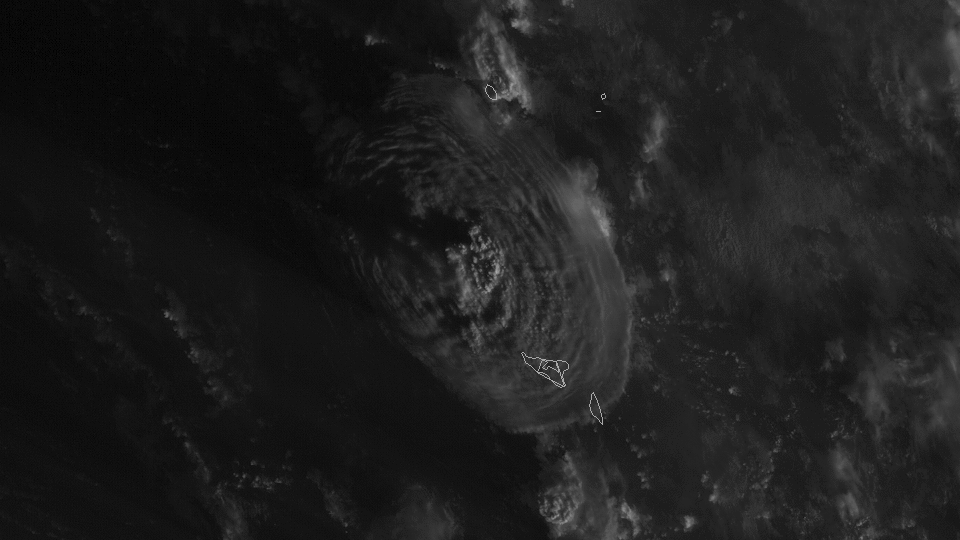12:30 PM | **More on the Tonga volcanic eruption of mid-January…the most powerful in 30 years...possible ramifications on global temperatures**
Paul Dorian
In the above visible satellite imagery loop, the extent of the ash plume can be seen as well as multiple rippling gravity waves that are emanating outward.
Overview
The Tonga volcanic eruption in mid-January, was the most powerful experienced on Earth in 30 years and the resultant ash cloud is still being studied to determine if it can have an impact on global climate. There was an immediate impact in the atmosphere by the eruption as pressure spikes were noted on barographs all around the world and even some evidence that these surges continued for several days later. Satellite imagery has shown that the ash cloud reached record high altitudes, but it is still unclear as to exactly how high up it penetrated and whether the amount deposited into those layers will be enough to impact global temperatures. The 1991 eruption of Mount Pinatubo in the Philippines – the second most powerful eruption of the 20th century – did indeed cool down the planet for a couple of years.
Pressure spikes were seen on barographs around the world following the Tonga volcanic eruption and, in this particular case on Easter Island in the Pacific, spikes were seen on back-to-back days. (arrows, pressure recorded here in 1-minute intervals).
Details
On December 20th, 2021, Hunga Tonga-Hunga Ha'apai - an underwater volcano in the South Pacific topped with an uninhabited island - awoke from a seven-year slumber. The volcano came to life in late December and generated a large plume of ash. Then, early in the morning on January 14th (local Tongan time), a plume shot way up into the sky as the volcano became increasingly turbulent. One day later, in the late afternoon of January 15th, satellites captured a tower of ash in a massive eruption that was unlike anything ever seen.
This plot from Miami, Florida suggests pressure surges may actually have been recorded as recently as Thursday, January 20th - some 5.5 days after the eruption. The initial wave arrived with a nearly 3mb peak-to-trough amplitude, and subsequent waves were 1.0, 0.5, 0.3mb, and into the noise where it was difficult to discern. From these well-timed anomalies, it has been calculated that the average speed of the shockwave was 707 mph (316 m/s). Plot and analysis by Brian McNoldy, Twitter (University of Miami).
The volcanic blast immediately created a shockwave that emanated from the site at around 600 miles per hour causing pressure spikes to be seen on barographs around the world. [In this 8-hour GOES-16 video clip you can see the wave front moving from left-to-right across the imagery; credit University of Wisconsin]. The shockwave resulted when the force of the blast displaced huge amounts of air outward and upward, high into the atmosphere. Gravity then acted on it by pulling it down only to rise up again and this up-down oscillation continued, creating a wave of alternating high and low pressure that moved outward from the blast source. In addition to the immediate impact on the pressure, the shockwave appears to have caused temperature perturbations that were measured by the Infrared Atmospheric Sounding Interferometer on the European MetOp satellite mission. The ocean was also immediately impacted by the blast as there were 4-foot tsunami waves within 20 minutes of the explosion that affected nearby islands and these waves ultimately reached Japan and the western shorelines of the Americas.
Mount Pinatubo erupted in the Philippines during 1991 and it produced a global cooling effect for up to two years afterwards. Data courtesy Dr. Roy Spencer, University of Alabama (Huntsville)
The potential impact of a volcanic eruption on global temperatures is largely the result of two factors: the height to which the ash cloud penetrates and the amount that reaches those levels. Both of these metrics are still yet to be fully determined with respect to the Tonga eruption, but history has shown that super volcanoes like Tonga can certainly send vast quantities of sulfur dioxide into the higher layers of the atmosphere which can – if in large enough amounts – have a cooling effect on the global climate. The gas combines with water to create aerosol particles that can reflect and scatter some the sun’s rays resulting in a cooling effect at the Earth’s surface.
Based on some of the preliminary satellite data, the estimated height of the eruption’s ash cloud reached an altitude of about 128,000 feet (39 kilometers) which, if confirmed, would make it the highest eruption in modern times. Still other researchers claim that the ash plume reached as high as 55 kilometers which is in the “mesosphere”, above the stratosphere and troposphere. The amount of ash that made it that high in the atmosphere is also still being evaluated; some preliminary estimates suggest that it was relatively small when compared to some other cataclysmic volcanic eruptions known from prior centuries.
This type of volcanic-related cooling effect was detected for up to two years following the 1991 eruption of Mount Pinatubo in the Philippines which lasted for several days. Estimates so far suggest the Tonga blast which lasted only about 10 minutes resulted in about 400,000 metric tons of sulfur dioxide reaching the stratosphere and that would be about 2% of the amount estimated from Mount Pinatubo’s eruption.
An ash cloud from the Mount Pinatubo eruption in the Philippines during 1991.
It will likely be several weeks before the final ratings are in with respect to the Tonga eruption including the height actually reached by the ash plume and the volume of sulfur dioxide that was put up into the upper part of the atmosphere…and whether or not there can be an impact on global temperatures.
Meteorologist Paul Dorian
Arcfield
arcfieldweather.com





